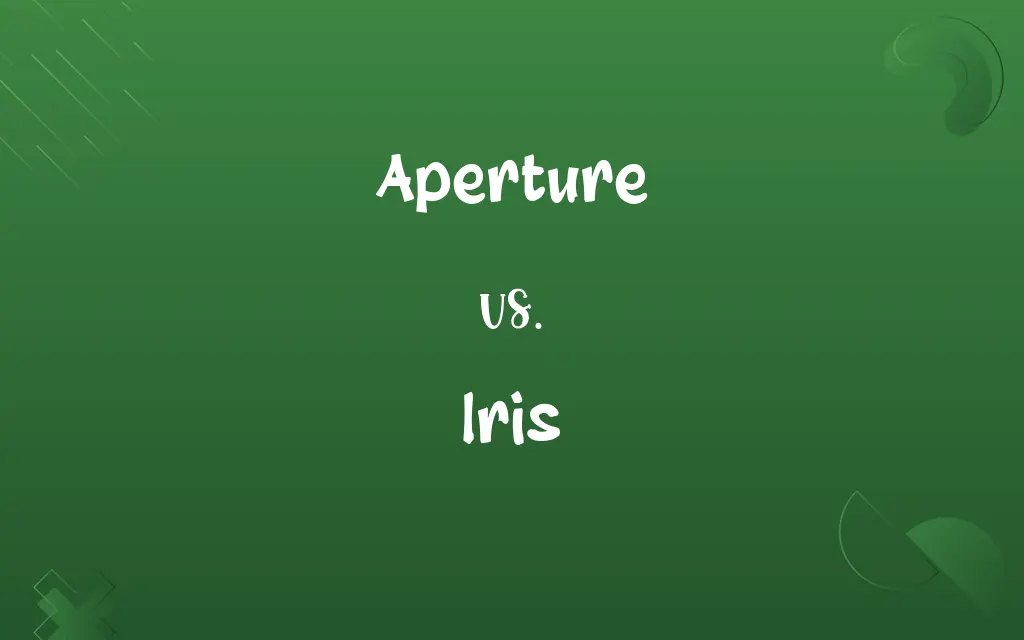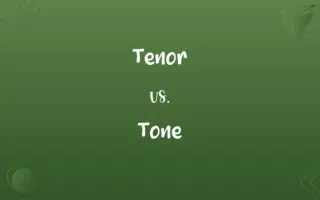Aperture vs. Iris: Know the Difference

By Hifza Nasir & Dua Fatima || Updated on March 4, 2024
Aperture refers to the opening in a lens through which light passes to enter the camera, while the iris is a part of the lens that adjusts the size of the aperture.

Key Differences
Aperture is a fundamental concept in photography and optics, defining the opening in a lens that allows light to reach the camera's sensor or film. It plays a crucial role in exposure and depth of field, determining how much light is permitted to enter. On the other hand, the iris is the component of the lens that creates the aperture. It consists of a series of overlapping blades that can expand or contract to adjust the aperture size, thereby controlling the amount of light that passes through.
Hifza Nasir
Mar 04, 2024
The size of the aperture is measured in f-stops, with lower numbers indicating larger openings and more light entering the camera. This affects not only the exposure but also the depth of field, which is the range of distance within a photo that appears sharp. Conversely, the iris's adjustment is what allows the aperture to change size. The iris mechanism is especially important in photography and videography as it enables the photographer or videographer to maintain control over exposure and depth of field dynamically.
Dua Fatima
Mar 04, 2024
In photography, a wide aperture (a low f-stop number) results in a shallow depth of field, making the subject stand out against a blurred background. This effect is desirable in portrait photography to focus attention on the subject. Whereas the iris, by adjusting to create a smaller aperture (a higher f-stop number), increases the depth of field, bringing more of the scene into sharp focus, which is beneficial in landscape photography.
Hifza Nasir
Mar 04, 2024
Aperture settings are critical for low-light photography; a larger aperture (smaller f-stop number) allows more light to reach the sensor, reducing the need for long exposures or high ISO settings that can introduce noise. In contrast, the iris's ability to reduce the aperture size is vital in bright conditions to prevent overexposure and retain detail in highlights and shadows.
Dua Fatima
Mar 04, 2024
The interaction between aperture and shutter speed determines the exposure of a photograph. A larger aperture allows for faster shutter speeds, freezing motion. Meanwhile, the iris's adjustments provide photographers with the flexibility to adapt to changing light conditions without sacrificing image quality or creative control.
Shumaila Saeed
Mar 04, 2024
ADVERTISEMENT
Comparison Chart
Definition
The opening in a lens that allows light to enter
The mechanism that adjusts the size of the aperture
Dua Fatima
Mar 04, 2024
Function
Controls the amount of light and depth of field
Adjusts to control light intake and depth of field
Hifza Nasir
Mar 04, 2024
Measurement
Measured in f-stops (e.g., f/1.8, f/16)
Not directly measured; affects aperture size
Hifza Nasir
Mar 04, 2024
Impact on Images
Affects exposure, depth of field, and blur
Enables flexibility in adjusting exposure and focus
Dua Fatima
Mar 04, 2024
Use in Photography
Chosen based on desired exposure and effect
Adjusted to suit lighting conditions and creative needs
Hifza Nasir
Mar 04, 2024
ADVERTISEMENT
Aperture and Iris Definitions
Aperture
Controls the brightness of the image.
To capture a night scene, a photographer might use a wide aperture to allow more light.
Hifza Nasir
Mar 04, 2024
Iris
Comprises overlapping blades that can expand or contract.
The iris creates a circular or hexagonal aperture shape, affecting the bokeh quality.
Hifza Nasir
Mar 04, 2024
Aperture
The size of the lens opening through which light enters.
A larger aperture, like f/2.8, allows for more light and a shallower depth of field.
Dua Fatima
Mar 04, 2024
Iris
Enables precise control over light and depth of field.
Videographers adjust the iris to maintain exposure during a shot.
Hifza Nasir
Mar 04, 2024
Aperture
Measured in f-stops, affecting exposure and depth of field.
Changing the aperture from f/4 to f/8 doubles the depth of field.
Hifza Nasir
Mar 04, 2024
ADVERTISEMENT
Iris
Acts dynamically to adjust for optimal exposure.
In automatic modes, the camera adjusts the iris based on ambient light.
Hifza Nasir
Mar 04, 2024
Aperture
A key setting in achieving desired photographic effects.
A small aperture (high f-stop) is used for landscape photography to ensure sharpness throughout the scene.
Dua Fatima
Mar 04, 2024
Iris
The part of the lens that controls the aperture size.
The iris adjusts to reduce light intake in bright conditions.
Dua Fatima
Mar 04, 2024
Aperture
Directly influences the aesthetic quality of the photo.
A wide aperture can create a beautiful bokeh effect in the background.
Hifza Nasir
Mar 04, 2024
Iris
Integral to both photography and videography for creative control.
Adjusting the iris allows for adjustments in depth of field without changing the lens.
Dua Fatima
Mar 04, 2024
Aperture
A usually adjustable opening in an optical instrument, such as a camera or telescope, that limits the amount of light passing through a lens or onto a mirror.
Hifza Nasir
Oct 19, 2023
Aperture
The diameter of such a hole which restricts the width of the lightpath through the whole system. For a telescope, this is the diameter of the objective lens.
Angular aperture
This telescope has a 100 cm aperture.
Hifza Nasir
Oct 19, 2023
Aperture
An opening; an open space; a gap, cleft, or chasm; a passage perforated; a hole; as, an aperture in a wall.
An aperture between the mountains.
The back aperture of the nostrils.
Hifza Nasir
Oct 19, 2023
Repeatedly Asked Queries
What is aperture in photography?
Aperture is the opening in a camera lens through which light passes to enter the camera, crucial for controlling the amount of light and the depth of field in photographs.
Dua Fatima
Mar 04, 2024
How does the iris function in a camera lens?
The iris is a part of the camera lens made up of several blades that expand and contract to adjust the size of the aperture, thus controlling the amount of light that enters the camera.
Hifza Nasir
Mar 04, 2024
Why is the iris important in photography and videography?
The iris is important because it allows for precise adjustments to the aperture size, enabling photographers and videographers to control exposure and depth of field in response to changing lighting conditions.
Dua Fatima
Mar 04, 2024
What role does the iris play in automatic camera modes?
In automatic camera modes, the iris adjusts automatically to control the aperture size based on the camera's metering and the desired exposure settings.
Dua Fatima
Mar 04, 2024
Can the aperture size affect image quality?
Yes, the aperture size can affect image quality by influencing exposure, depth of field, and the potential for diffraction at very small apertures, which can reduce sharpness.
Shumaila Saeed
Mar 04, 2024
What is the relationship between aperture and depth of field?
Aperture size directly affects the depth of field in an image; a larger aperture (smaller f-stop number) results in a shallower depth of field, while a smaller aperture (larger f-stop number) increases the depth of field.
Hifza Nasir
Mar 04, 2024
What is bokeh, and how is it related to aperture?
Bokeh refers to the aesthetic quality of the blur in the out-of-focus areas of an image; it is influenced by the aperture size, with larger apertures producing a more pronounced bokeh effect.
Dua Fatima
Mar 04, 2024
How do aperture settings impact exposure?
Aperture settings impact exposure by controlling the amount of light that reaches the camera sensor; a larger aperture increases exposure by allowing more light, while a smaller aperture decreases it.
Hifza Nasir
Mar 04, 2024
Is it better to have a camera lens with a larger maximum aperture?
A larger maximum aperture offers more flexibility in low light conditions and for achieving shallow depth of field effects, but the best choice depends on the photographer's needs and style.
Dua Fatima
Mar 04, 2024
How does changing the aperture affect shutter speed?
Changing the aperture affects shutter speed as a wider aperture (lower f-stop) allows faster shutter speeds due to more light entering, and a smaller aperture requires slower shutter speeds to achieve the same exposure.
Dua Fatima
Mar 04, 2024
How does the iris affect video recording?
The iris affects video recording by allowing the videographer to adjust the depth of field and exposure in real-time, crucial for maintaining consistent visual quality.
Dua Fatima
Mar 04, 2024
Share this page
Link for your blog / website
HTML
Link to share via messenger
About Author
Written by
Hifza NasirCo-written by
Dua Fatima





































































